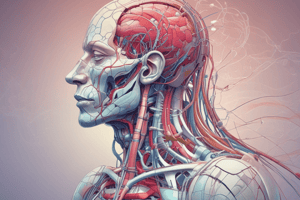Podcast
Questions and Answers
rate at which breathing occurs per min.
rate at which breathing occurs per min.
respiratory rate
adult normal breathing rate
adult normal breathing rate
12-20 bpm
bradypnea
bradypnea
slow breathing rate
breathing that stops
breathing that stops
means breathe
means breathe
higher than normal breathing rate
higher than normal breathing rate
force of the blood pushing against the artery walls
force of the blood pushing against the artery walls
MIP
MIP
EPS
EPS
the peak artery pressure during the beats is called diastolic
the peak artery pressure during the beats is called diastolic
amount of pressure during the heart is at rest is called systolic
amount of pressure during the heart is at rest is called systolic
is the sound heard when taking blood pressure
is the sound heard when taking blood pressure
parts of stethoscope
parts of stethoscope
parts of sphygmomanometer
parts of sphygmomanometer
high bp
high bp
low bp
low bp
another term for vital signs
another term for vital signs
what is vital signs
what is vital signs
BP apparatus
BP apparatus
slow heart rate
slow heart rate
faster than normal heart rate
faster than normal heart rate
body temperature area
body temperature area
body pulse area
body pulse area
why is hand washing important?
why is hand washing important?
act of cleaning ones hands
act of cleaning ones hands
Flashcards are hidden until you start studying
Study Notes
Breathing Rate
- The normal breathing rate for an adult is 12-20 breaths per minute.
- Bradypnea refers to a breathing rate that is slower than normal.
- Apnea is a period where breathing stops.
- Tachypnea is a breathing rate that is higher than normal.
Blood Pressure
- The force of blood pushing against artery walls is blood pressure.
- The peak artery pressure during heartbeats is called systolic pressure.
- The amount of pressure in the heart when it is at rest is called diastolic pressure.
- The sounds heard when taking blood pressure are Korotkoff sounds.
Medical Equipment
- A sphygmomanometer is a device used to measure blood pressure.
- A stethoscope has two main parts: the diaphragm and the bell.
Vital Signs
- Vital signs are essential signs of life, including pulse, breathing rate, blood pressure, and body temperature.
- Another term for vital signs is essential signs.
- BP apparatus is used to measure blood pressure, a vital sign.
Heart Rate
- Tachycardia is a heart rate that is faster than normal.
- Bradycardia is a heart rate that is slower than normal.
Body Temperature and Pulse
- The normal body temperature area is the axillary region (armpit).
- The normal body pulse area is the radial artery (wrist).
Hand Washing
- Hand washing is the act of cleaning one's hands to prevent infection.
- Hand washing is important to prevent the spread of diseases.
Studying That Suits You
Use AI to generate personalized quizzes and flashcards to suit your learning preferences.



